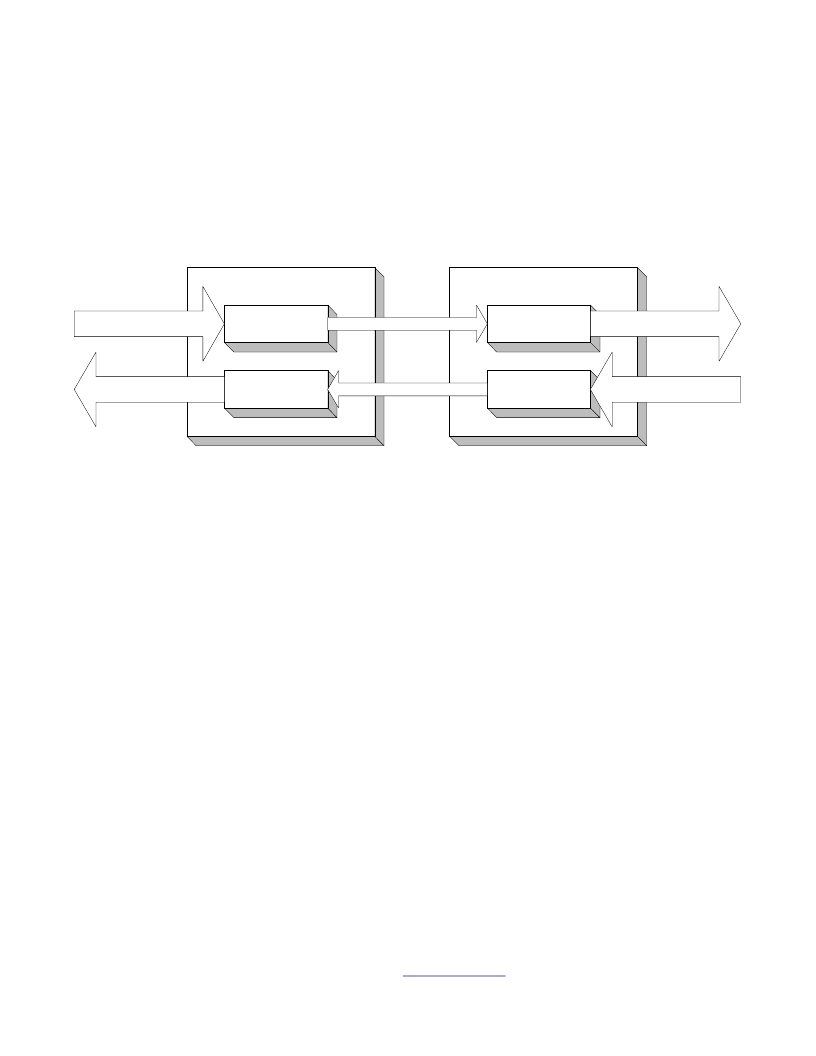- 您現在的位置:買賣IC網 > PDF目錄379665 > AMBE2000 (Electronic Theatre Controls, Inc.) VOCODER CHIP PDF資料下載
參數資料
| 型號: | AMBE2000 |
| 廠商: | Electronic Theatre Controls, Inc. |
| 英文描述: | VOCODER CHIP |
| 中文描述: | 聲碼器芯片 |
| 文件頁數: | 8/47頁 |
| 文件大小: | 324K |
| 代理商: | AMBE2000 |
第1頁第2頁第3頁第4頁第5頁第6頁第7頁當前第8頁第9頁第10頁第11頁第12頁第13頁第14頁第15頁第16頁第17頁第18頁第19頁第20頁第21頁第22頁第23頁第24頁第25頁第26頁第27頁第28頁第29頁第30頁第31頁第32頁第33頁第34頁第35頁第36頁第37頁第38頁第39頁第40頁第41頁第42頁第43頁第44頁第45頁第46頁第47頁

AMBE-2000 Vocoder Chip
User’s Manual Version 3.0
page 8
Visit us at
www.dvsinc.com
Confidential Proprietary, Subject to Change
2 AMBE -2000 Application Design Overview
2.1 Basic Operation
In its simplest model, the AMBE-2000 can be viewed as two separate components, the
Encoder
and the
Decoder
. The
Encoder receives an 8kHz. sampled stream of
speech
data (16-bit linear, 8-bit Alaw, or 8-bit ulaw) and outputs a stream of
channel
data at the desired rate. Conversely the Decoder receives a stream of
channel
data and synthesizes a stream of
speech
data. The timing for the interfaces for the AMBE-2000 Encoder and Decoder are fully asynchronous.
Figure 2-A Basic Operation
AMBE-2000
Encoder
8kHz Speech Data
Decoder
8kHz Speech Data
AMBE-2000
Decoder
8kHz Speech Data
Encoder
8kHz Speech Data
Compressed Data @ 2400-9600bps
Compressed Data @ 2400-9600bps
Typically the speech interface is an external A/D-D/A chip. The format of the incoming and outgoing speech data streams are
coupled, that is to say they must be the same format (16-bit linear, 8-bit Alaw, or 8-bit
μ
law). The channel interface is
commonly (but not limited to) an 8 or 16 bit microprocessor or other suitable ‘glue logic’ hardware capable of performing the
rudimentary formatting functions between the AMBE-2000 channel format and the format of the system channel under
design.
Optional functions of the chip, such as echo cancellation, voice activation/detection, power mode control, data/FEC rate
selection, etc. are controlled either through hardware control pins (see Section 0) and/or through the decoder command
interface (see Section 4) Data sent into the decoder for function control purposes is distinguished from the data to be decoded
into speech through a channel format which is described in Section 4.
2.2
Initial Design Considerations
Some of the initial design considerations the application engineer will face are the following:
Choice of A/D-D/A chip.
Choice of Channel Interface.
Speech and FEC Rates.
2.2.1
A/D – D/A Overview
The choice of the A/D-D/A chip is critical to designing a system with superior voice quality. Given that Alaw and
μ
law
companding chips are already incorporating some compression to reduce the number of bits per sample, it is recommended
that, when possible, a 16-bit linear device be used for maximum voice quality. When choosing a device, pay particular
attention to Signal to Noise ratios and Frequency Responses of any filters that may be present on the analog front end of these
chips. The Alaw and
μ
law interfaces are also provided for the design engineer who is trying to fit to pre-existing conditions or
is under other cost type restraints.
相關PDF資料 |
PDF描述 |
|---|---|
| AMC0802A | CONTOUR DRAWING & BLOCK DIAGRAM |
| AMC317 | 1.5A / 3- TERMINAL ADJUSTABLE REGULATOR |
| AMC317T | 1.5A / 3- TERMINAL ADJUSTABLE REGULATOR |
| AMC317ST | 1.5A / 3- TERMINAL ADJUSTABLE REGULATOR |
| AMC5902 | 6CH Motor Driver for CD-ROM, DVD-ROM |
相關代理商/技術參數 |
參數描述 |
|---|---|
| AMB-EHS160 | 制造商:Schroff/Pentair Electronic Packaging 功能描述: |
| AMBF22 | 制造商:ABRACON 制造商全稱:Abracon Corporation 功能描述:MULTILAYER CHIP BALANCE-EMI FILTER |
| AMBI LIGHT SENSOR | 制造商:LIQUIDWARE 功能描述:Ambient Light Sensor |
| AMB-KIT1 | 功能描述:TEST LEAD SET FOR INSUL RESIST 制造商:amprobe 系列:AMB 包裝:袋 零件狀態:有效 套件類型:測試引線 內容:短頭鱷魚夾,測試引線,測試探針 標準包裝:1 |
| AMB-KIT2 | 制造商:Amprobe Test Tools 功能描述:10 KV SHIELDED LEAD WITH TIP FOR AMB-110 AMB-110 |
發布緊急采購,3分鐘左右您將得到回復。